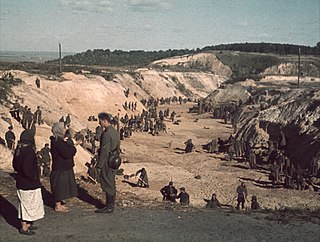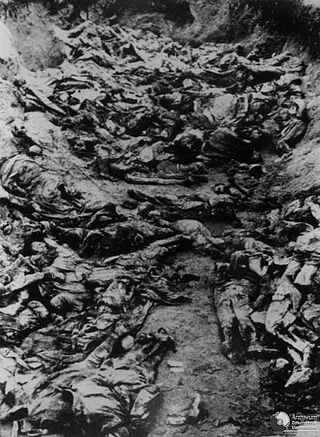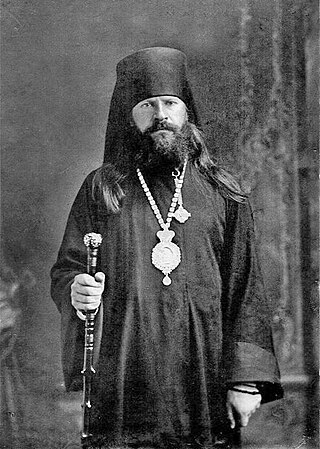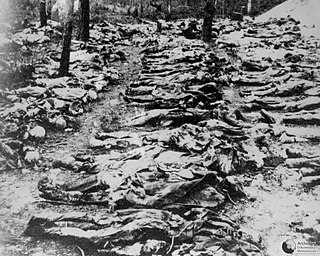
The Nuremberg trials were held by the Allies against representatives of the defeated Nazi Germany for plotting and carrying out invasions of other countries across Europe and atrocities against their citizens in World War II.

Babi Yar or Babyn Yar is a ravine in the Ukrainian capital Kyiv and a site of massacres carried out by Nazi Germany's forces during its campaign against the Soviet Union in World War II. The first and best documented of the massacres took place on 29–30 September 1941, killing some 33,771 Jews. Other victims of massacres at the site included Soviet prisoners of war, communists and Romani people. It is estimated that a total of between 100,000 and 150,000 people were murdered at Babi Yar during the German occupation.

Katyn is a rural locality in Smolensky District of Smolensk Oblast, Russia, located approximately 20 kilometers (12 mi) to the west of Smolensk, the administrative center of the oblast. The village had a population of 1,737 in 2007.

The Black Book of Soviet Jewry or simply The Black Book, also known as The Complete Black Book of Russian Jewry, is a 500-page document compiled for publication by Ilya Ehrenburg and Vasily Grossman originally in late 1944 in the Russian language. It was a result of the collaborative effort by the Jewish Anti-Fascist Committee (JAC) and members of the American Jewish community to document the anti-Jewish crimes of the Holocaust and the participation of Jews in the resistance movement against the Nazis during World War II. The 1991 Kyiv edition of The Black Book was subtitled The Ruthless Murder of Jews by German-Fascist Invaders Throughout the Temporarily-Occupied Regions of the Soviet Union and in the German Nazi Death Camps established on occupied Polish soil during the War 1941–1945.

The 1940 AB-Aktion, a second stage of the Nazi German campaign of violence in Poland during World War II, aimed to eliminate the intellectuals and the upper classes of the Second Polish Republic across the territories slated for eventual annexation by the German Reich.

Nikolay Nilovich Burdenko was a Russian and Soviet surgeon, the founder of Russian neurosurgery. He was Surgeon-General of the Red Army (1937–1946), an academician of the USSR Academy of Sciences, an academician and the first director of the Academy of Medical Sciences of the USSR (1944–1946), a Hero of Socialist Labor, Colonel General of medical services, and a Stalin Prize winner (1941). He was a veteran of the Russo-Japanese War, First World War, Winter War and the German-Soviet War.

The war crimes and crimes against humanity which were perpetrated by the Soviet Union and its armed forces from 1919 to 1991 include acts which were committed by the Red Army as well as acts which were committed by the country's secret police, NKVD, including its Internal Troops. In many cases, these acts were committed upon the orders of the Soviet leaders Vladimir Lenin and Joseph Stalin in pursuance of the early Soviet government's policy of Red Terror. In other instances they were committed without orders by Soviet troops against prisoners of war or civilians of countries that had been in armed conflict with the USSR, or they were committed during partisan warfare.
The United Nations War Crimes Commission (UNWCC) initially called the United Nations Commission for the Investigation of War Crimes, was a commission of the United Nations that investigated allegations of war crimes committed by Nazi Germany and the other Axis powers in World War II.

Valentina Stepanovna Grizodubova was one of the first female pilots in the Soviet Union awarded the title Hero of the Soviet Union and the only female Hero of the Soviet Union to also be awarded the title Hero of Socialist Labour.

The Katyn massacre was a series of mass executions of nearly 21,857 Polish military officers and intelligentsia prisoners of war carried out by the Soviet Union, specifically the NKVD in April and May 1940. Though the killings also occurred in the Kalinin and Kharkiv prisons and elsewhere, the massacre is named after the Katyn forest, where some of the mass graves were first discovered by German Nazi forces.
As a result of the Soviet invasion of Poland in 1939, hundreds of thousands of Polish soldiers became prisoners of war. Many of them were executed; 22,000 Polish military personnel and civilians perished in the Katyn massacre alone.
A number of war crimes trials were held during the Soviet occupation of Estonia (1944–1991). The best-known trial was brought in 1961, by the Soviet authorities against local collaborators who had participated in the Holocaust during the German occupation (1941–1944). The accused were charged with murdering up to 5,000 German and Czechoslovakian Jews and Romani people near the Kalevi-Liiva concentration camp in 1942–1943. The public trial by the Supreme Court of the Estonian SSR was held in the auditorium of the Navy Officers Club in Tallinn and attended by a mass audience. All three defendants were convicted and sentenced to death, one in absentia. The two defendants present for the trial were executed shortly after. The third defendant, Ain-Ervin Mere, was not available for execution.

Katyń is a 2007 Polish historical drama film about the 1940 Katyn massacre, directed by Academy Honorary Award winner Andrzej Wajda. It is based on the book Post Mortem: The Story of Katyn by Andrzej Mularczyk. It was nominated for Best Foreign Language Film for the 80th Academy Awards.

The Vinnytsia massacre was the mass execution of between 9,000 and 11,000 people in the Ukrainian town of Vinnytsia by the Soviet secret police NKVD during the Great Purge in 1937–1938, which Nazi Germany discovered during its occupation of Ukraine in 1943. The investigation of the site first conducted by the international Katyn Commission coincided with the discovery of a similar mass murder site of Polish prisoners of war in Katyn. Among the 679 dead identified by the Germans in 1943, there were also a certain number of Russians and 28 Poles. Nazi propaganda invoked mention of the massacre to illustrate communist terror by the Soviet Union.

Metropolitan Nicholas, was the Metropolitan of Kiev in the Patriarchate of Moscow.
The Tatarka common graves were mass graves discovered in April–August 1943, during World War II, by Axis-allied Romanian troops occupying Transnistria, on a lot of 1,000 m2 (11,000 sq ft) in Tatarka, now Prylymanske, in Odesa Raion, near Odesa. Some 42 separate common graves of several dozen bodies each were identified, containing between 3,500 and 5,000 bodies, of which 516 were exhumed, studied, and buried in a cemetery before the region became a front line. The commission set up by the Romanian authorities to investigate these graves reported that among the dead were persons arrested in the Moldavian ASSR in 1938–1940 and in Bessarabia and northern Bukovina in 1940–1941.

Anti-Katyn is a denialism campaign intended to reduce and obscure the significance of the Katyn massacre of 1940 — where approximately 22,000 Polish officers were murdered by the Soviet NKVD on the orders of Joseph Stalin — by referencing the deaths from disease of thousands of Imperial Russian and Red Army soldiers at Polish internment camps during the Interwar period.

The Katyn Commission or the International Katyn Commission was a committee formed in April 1943 under request by Germany to investigate the Katyn massacre of some 22,000 Polish nationals during the Soviet occupation of Eastern Poland, mostly prisoners of war from the invasion of Poland including Polish Army officers, intelligentsia, civil servants, priests, police officers and numerous other professionals. Their bodies were discovered in a series of large mass graves in the forest near Smolensk in Russia following Operation Barbarossa.
Nuremberg: The Nazis Facing their Crimes is a 2006 documentary about the Nuremberg Trials made by French historian and director Christian Delage and coproduced by La Compagnie des Phares et Balises and ARTE France. The English version, narrated by Christopher Plummer, premiered at the Lincoln Center in 2007.
The Select Committee to Conduct an Investigation and Study of the Facts, Evidence, and Circumstances of the Katyn Forest Massacre was established by United States House of Representatives in 1951, during the Korean War. At that time, there was concern that the Katyn Massacre could have served as a "blueprint" for the execution of U.S. troops by Communist forces.














